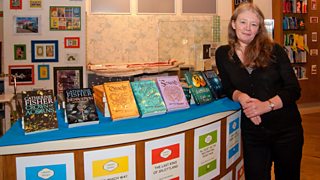No question, doing a long-running book programme can really widen your shelves.
You find yourself reading stuff you normally wouldn't go near, and enjoying it more than you could ever have imagined. Chicklit, for example. Surprising what blokes can learn from chicklit.
But we all have a blind spot and mine's a certain kind of fantasy saga. It usually comes in about 12 volumes and involves people living in some distant galaxy who all wear medieval kit and are able to work magic. These doorstops, famous for being satirised by Terry Pratchett, almost always have a chunky collective title like...
....well, like The Chronoptika.
The first volume of which arrived in the post a couple of weeks ago. And I have to confess, if its author hadn't been Catherine Fisher it might well, by now, have been on its way to the Cats' Protection League shop.

Catherine Fisher. Photo 漏 Literature Wales
Catherine, from Newport, is one of Britain's most critically-acclaimed authors of fantasy fiction aimed at Young Adults. That's teenagers, basically. Her last series, said to have sold half a million copies worldwide, was called The Incarceron.
So why - given that I'm supposed to hate fantasy and couldn't pass as a young adult in even a very dim light - did I enjoy volume one of The Chronoptika so much?
I didn't know. So we've used up an entire edition of finding out.
It all seems to come down to your definition of the term fantasy and the question of whether you can suspend belief. The term 'a work of the imagination' tends to scare me away, as do stories set in 'a distant world'.
Few writers are capable of imagining a distant world which is completely unlike this one - hence all that stuff about elves wearing chain mail which offers absolutely no protection against laser-like cosmic rays.
Admittedly, The Obsidian Mirror, first volume in The Chronoptika, has some mind-boggling stuff in it, including time-travel. But it isn't set on some distant planet, it's set on this one and is grounded in British history and legends. It has a deep dark wood. What it says is: there could be more to this world than you know.
And I like that, because it puts Catherine Fisher's series firmly into possibly the oldest genre in fiction: the fairy story.
The original fairy stories weren't for kids. The fairies in folklore don't have gossamer wings and little wands with a star on the end. Real fairies are scary. They look like us, but don't be fooled. They have no morals and appear to live for self-gratification. And they don鈥檛 like us much.
In this Sunday's programme we also discuss a fairy story for adults by Graham Joyce, for which no suspension of disbelief is required. You WILL believe. Well, I did, anyway, because the novel is set in a town near you, full of engaging but convincingly normal people. Except for Tara, who is 36 but looks 16. Some Kind of Fairy Tale bends our concept of reality just enough to make us uneasy.
We also talk to Elizabeth Holley, whose first children's book has kids riding on a dragon's back, but stays just this side of silly because it's set in a remote and insular part of Wales, where some mysteries in the landscape have never been solved.
What all these books show is that a deep dark wood, even one from which you can still hear the M4, can be far more disturbing than some Darth Vader clone with a death ray.
Or maybe I just haven't quite grown up...
Listen to Phil the Shelf on this Sunday from 1.30pm.
